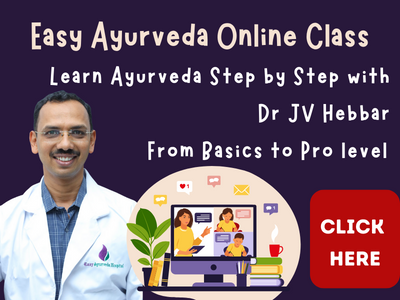Ashtanga Hrudaya Sutra Sthana Chapter 1: Basic Principles of Ayurveda
Ashtanga Hridayam is an Ancient Ayurvedic text book. It is one of the basic text books that every Ayurveda student reads in the first year. Here, we are covering the details of the First chapter.
Chapter name: Ayushkameeya Adhyaya “Desire for long life”
Table of Contents
Salutations
1. Salutations to The Unique and Rare Physician, who has destroyed, without any residue all the diseases like Raga (lust, anger, greed, arrogance, jealousy, selfishness, ego), which are constantly associated with the body, which is spread all over the body, giving rise to disease, delusion and restlessness.
This salutation is done to Lord Dhanwantari.
Shloka recitation video
2. Purpose of life: Essential quality to learn Ayurveda
आयु: कामायमानेन धर्मार्थ सुखसाधनम् । आयुर्वेदोपदेशेषु विधेय: परमादर: ॥
āyu: kāmāyamānena dharmārtha sukhasādhanam | āyurvedopadeśeṣu vidheya: paramādara: ||
To achieve the purpose of life, that is
- Dharma – following the path of righteousness
- Artha – earning money in a legal way
- Kama – fulfilling our desire
- Moksha – achieving salvation
To achieve this purpose of life, one should concentrate on having a long life. To learn the science of Ayurveda, which explains how to achieve this purpose, ‘obedience’ (Vidheya) is the most important quality.
3. Origin of Ayurveda
Lord Brahma, remembering Ayurveda, taught it to Prajapathi, he in turn taught it to Ashwini Kumaras (twins), they taught it to Sahasraksa (Lord Indra), he taught it to Atri’s son (Atreya Punarvasu) and other sages, they taught it to Agnivesa and others and they (Agnivesha and other disciples ) composed treatises, each one separately.
4 – 4.5. Funda of Ashtanga Hrudayam
From those Ayurvedic text books, which are too elaborate and hence very difficult to study, only the essence is collected and presented in Ashtanga Hridaya, which is neither too short nor too elaborate.
4.5-5.5 – Branches of Ayurveda
कायबालग्रहोर्ध्वाङ्ग शल्यदंष्ट्रा जरावृषान् || अष्टावङ्गानि तस्याहु: चिकित्सा येषु संश्रिता |
kāyabālagrahordhvāṅga śalyadaṃṣṭrā jarāvṛṣān || aṣṭāvaṅgāni tasyāhu: cikitsā yeṣu saṃśritā |
- Kaya Chikitsa – General medicine
- Bala Chikitsa – Pediatrics
- Graha Chikitsa – Psychiatry
- Urdhvanga Chikitsa – Diseases and treatment of Ear, Nose, Throat, Eyes and Head (neck and above region)
- Shalya Chikitsa – Surgery
- Damshtra Chikitsa – Toxicology
- Jara Chikitsa – Geriatrics
- Vrushya Chikitsa – Aphrodisiac therapy
These are the eight branches of Ayurveda.
5.5 – 6.5 Tridosha
वायु: पित्तं कफश्चेति त्रयो दोषा: समासत: ॥ विकृताऽविकृता देहं घ्नन्ति ते वर्त्तयन्ति च ।
vāyu: pittaṃ kaphaśceti trayo doṣā: samāsata: || vikṛtā’vikṛtā dehaṃ ghnanti te varttayanti ca |
Vayu – Vata, Pitta and kapha are the three Doshas of the body. Perfect balance of three Doshas leads to health, imbalance in Tridosha leads to diseases.
6.5-7.5 Tridosha dominance in body and in a day
ते व्यापिनोऽपि हृन्नाभ्योरधोमध्योर्ध्व संश्रया: ॥ वयोऽहोरात्रिभुक्तानां तेऽन्तमध्यादिगा: क्रमात् ।
te vyāpino’pi hṛnnābhyoradhomadhyordhva saṃśrayā: || vayo’horātribhuktānāṃ te’ntamadhyādigā: kramāt |
The Tridosha are present all over the body, but their presence is especially seen in particular parts. If you divide the body into three parts, the top part up to the chest is dominated by Kapha Dosha, between chest and umbilicus is dominated by Pitta, part below umbilicus is dominated by Vata.
Similarly when the day is divided as morning, afternoon and night (separately), the first part is dominated by Kapha, second part is dominated by Pitta and third part is dominated by Vata. While eating and during digestion, the first, second and third part are dominated by Kapha, Pitta and Vata respectively.
Related article – Understand the dominance of Doshas in the body
7.5 Types of digestive fires
तैर्भवेद्विषम: तीक्ष्णो मन्दश्चाग्नि: समै: सम: ॥
tairbhavedviṣama: tīkṣṇo mandaścāgni: samai: sama: ||
There are four types of Digestive fires (Agni)
Vishama Agni – Influenced by Vata. A person with Vishama Agni will sometimes have high appetite, and sometimes, low appetite.
Teekshna Agni – Influenced by Pitta. A person with Teeksna Agni will have high digestion power and appetite.
Manda Agni – Influenced by Kapha. A person with Manda Agni will have low digestion power and appetite.
Sama Agni – Influenced by perfect balance of Tridosha – Where person will have proper appetite and digestion power. Digestion occurs at appropriate time.
8.5 Types of digestive tracts / nature of bowels
कोष्ठ: क्रूरो मृदुर्मध्यो मध्य: स्यात्तै: समैरपि ।
koṣṭha: krūro mṛdurmadhyo madhya: syāttai: samairapi |
There are three types of digestive tracts (Koshta)
Kroora Koshta – wherein the person will take long time for digestion. The bowel evacuation will be irregular. It is influenced by Vata.
Mrudu Koshta – Sensitive stomach, has a very short digestion period. Even administration of milk will cause bowel evacuation.
Madhya Koshta – Proper digestive tract, bowel evacuation at appropriate times. It is influenced by Tridosha balance.
9-10 Types of Prakruti – Body Types
शुक्रार्तवस्थै: जन्मादौ विषेणैव विषकृमे: ॥ तैश्च तिस्र: प्रकृतयो हीनमध्योत्तमा: पृथक् ।
समधातु: समस्तासु श्रेष्ठा निन्द्या द्विदोषजा ॥
śukrārtavasthai: janmādau viṣeṇaiva viṣakṛme: || taiśca tisra: prakṛtayo hīnamadhyottamā: pṛthak |
samadhātu: samastāsu śreṣṭhā nindyā dvidoṣajā ||
Like the poison is natural and inherent to poisonous insects, similarly, the Prakruti (body type) is inherent to humans. The body type is decided during conception, based on qualities of sperm and ovum.
Vata prakruti – Vata body type is considered as low quality
Pitta Prakruti – Pitta body type is considered as moderate quality
Kapha body type is considered good quality.
Tridosha body type – influenced equally by Vata, Pitta and Kapha is considered the best quality.
Dual body types, Like Vata-Pitta, Pitta-Kapha, Vata-Kapha body types are considered as not good.
10.5 Qualities of Vata
तत्र रूक्षो लघु: शीत: खर: सूक्ष्मश्चलोऽनिल: ॥
tatra rūkṣo laghu: śīta: khara: sūkṣmaścalo’nila: ||
Rooksha – dryness, Laghu – Lightness, Sheeta – coldness, Khara – roughness, Sookshma – minuteness, Chala – movement. These are the qualities of Vata.
11. Qualities of Pitta
पित्तं सस्नेह तीक्ष्णोष्णं लघु विस्रं सरं द्रवम् ।
pittaṃ sasneha tīkṣṇoṣṇaṃ laghu visraṃ saraṃ dravam |
Sasneha – slightly oily, unctuous, Teekshna – piercing, entering into deep tissues, Ushna – hotness, Laghu – lightness, Visram – bad smell, sara – having fluidity, movement, drava – liquidity are the qualities of Pitta.
12. Qualities of Kapha
स्निग्ध: शीतो गुरुर्मन्द: श्लक्ष्णो मृत्स्न: स्थिर: कफ: ॥
snigdha: śīto gururmanda: ślakṣṇo mṛtsna: sthira: kapha: ||
Snigdhna – oily, unctuous, Sheeta – cold, Guru – heavy, Manda – mild, viscous, shlakshna – smooth, clear, Mrutsna – slimy, jelly like, sthira – stability, immobility are the qualities of Kapha.
The increase, decrease of individual Doshas, or imbalance of couple of these Doshas is called as Samsarga and imbalance of all the three Doshas together is called as Sannipata.
Related – understand Tridosha by means of qualities
13. Body tissues and waste products
रस असृक् मांस मेदो अस्थि मज्ज शुक्राणि धातव: । सप्त दूष्या: मला: मूत्र शकृत् स्वेदादयोऽपि च ॥
rasa asṛk māṃsa medo asthi majja śukrāṇi dhātava: | sapta dūṣyā: malā: mūtra śakṛt svedādayo’pi ca ||
Body tissues and waste products are called as Dushyas. It means, these are influenced and affected by Doshas. Body tissues are –
- Rasa – the first product of digestion. Soon after digestion of food, the digested food turns into Rasa. It is grossly compared to lymph or plasma. But it is not a complete comparison.
- Rakta – Also called as Asruk. – Blood
- Mamsa – Muscle
- Meda – Fat tissue
- Asthi – Bones and cartilages
- Majja – Bone marrow
- Shukra – Semen / Ovum or entire male and female genital tract and its secretions are grossly covered under this heading.
Mala – waste products
Shakrut / Pureesha – (faeces), Sweda (sweat) and Mootra (urine) are the three waste products of the body.
13.5 Nature of increase and decrease
वृद्धि: समानै: सर्वेषां विपरीतै: विपर्यय: ।
vṛddhi: samānai: sarveṣāṃ viparītai: viparyaya: |
Equal qualities lead to increase, and opposing qualities lead to decrease. For example, dryness is the quality of Vata. If a Vata body type person exposes himself to dry cold weather, his dryness and in turn Vata will increase, leading to dry skin.Oiliness is the opposite quality of dryness. If he applies oil to the skin, then the dryness and related Vata is decreased.
13.5 Six tastes
Svadu – Madhura – sweet, Amla – Sour, Lavana – Salt, Tikta – Bitter, Ushna – Katu – Pungent, Kashaya – Astringent are the six types of Rasa.
They are successively lower in energy. That means, Sweet taste imparts maximum energy to body and the astringent, the least.
14. Effect of tastes on Tridosha
तत्राद्या मारुतं घ्नन्ति त्रय: तिक्तादय: कफम् । कषाय तिक्त मधुरा: पित्तमन्ये तु कुर्वते ॥
tatrādyā mārutaṃ ghnanti traya: tiktādaya: kapham | kaṣāya tikta madhurā: pittamanye tu kurvate ||
In the list of tastes, the first three, i.e. Sweet, sour and salt mitigates Vata and increases Kapha. The last three, i.e. bitter, pungent and astringent tastes mitigates Kapha and increases Vata. Astringent, bitter and sweet taste mitigates Pitta. Sour, salt and pungent tastes increase Pitta.
Types of food substances
Shamana – Food that brings down the increased Dosha to normalcy
Kopana – Food that increases the lowered Dosha to normalcy
Swasthahita – Food that maintains the normalcy of Tridosha and health.
Types of Potency (Veerya)
Ushna veerya (Hot potency) –
Some food items are hot in nature. For example pepper
Sheeta veerya (cold potency) – Some food items are cold in nature. For example milk. These are the two types of potencies. Generally, substances that have Astringent, bitter and sweet tastes are coolant in nature and Sour, salt and pungent tastes are hot in nature.
Three types of Vipaka
Vipaka refers to conversion of taste after initial phase of digestion.
Madhura Vipaka (sweet) – Generally, Sweet, and salt tastes undergo this Vipaka.
Amla Vipaka (Sour) – Sour taste undergoes this Vipaka
Katu Vipaka – rest of the tastes – Bitter, astringent and pungent tastes undergo this Vipaka.
18. Twenty types of qualities
गुरु मन्द हिम स्निग्ध श्लक्ष्ण सान्द्र मृदु स्थिरा: । गुणा: ससूक्ष्म विशदा: विंशति: स विपर्यया: ॥
guru manda hima snigdha ślakṣṇa sāndra mṛdu sthirā: | guṇā: sasūkṣma viśadā: viṃśati: sa viparyayā: ||
Guru(heavy) X laghu (light in weight)
Manda(slow) X tikshna(quick,fast)
Hima (cold) X ushna (hot)
Snighda (unctuous) X ruksa (dry)
Slaksna (smooth) X khara (rough)
Sandra (solid) X drava (liquid)
Mrdu (soft) X kathina (hard)
Sthira (stable) X cala (moving, unstable)
Suksma (stable, small) X sthula (big,gross)
Vishada (non slimy) X picchila (slimy)
19. Cause for health and disease
कालार्थकर्मणां योगो हीनमिथ्यातिमात्रक: । सम्यग्योगश्च विज्ञेयो रोगारोग्यैक कारणम् ॥
kālārthakarmaṇāṃ yogo hīnamithyātimātraka: | samyagyogaśca vijñeyo rogārogyaika kāraṇam ||
Less, more or wrong unison of time, senses and functions is the reason for disease and the right unison of these three factors is the reason for health. (Explained in detail in further chapters).
20. Definition of health and disease
रोगस्तु दोषवैषम्यं दोष साम्यं अरोगता । rogastu doṣavaiṣamyaṃ doṣa sāmyaṃ arogatā |
Imbalance in Tridosha is disease. Perfect balance is health.
21. Types of disease
Nija roga – Disease caused due to imbalance in internal factors. For example, eating excessive hot substances, leading to gastritis.
Agantu Roga – Disease caused due to external factors. Such as injuries. Both these types of disease can occur to body and mind.
21. Types of mental Doshas
Rajas – quality of mind, that drives us to take actions,
Tamas – that leads to inaction and lethargy
22. How to test patient?
Darshana – by means of inspection, observation.
Sparshana – by means of touching
Prashna – by means of asking
23. Examination of disease
Disease should be examined by its
Nidana -causes, etiology,
Pragrupa – Purvarupa – prodromal symptoms, premonitory symptoms
Lakshana – Specific signs and symptoms, clinical features
Upashayaa – diagnostic tests
Apti – Samprapti – Pathogenesis.
Types of Habitat (Desha)
In this science, is said to be of two kinds – Bhumi desha – region of land and Dehadesha – the body. Bhumi desa – land region is of three kinds viz,
Jangala -which is predominant of vata – arid or desert-like land with no mountains or hills, has less vegetation, poor water resources and is more breezy.
Anupa – which is predominant of kapha – marshy land with more of water, more vegetation , very less of sunlight and heat.
Sadharana which has all Tridosha in balance – moderate type with few mountains , hills, moderate water, vegetation and sunlight.
Kinds of time
Two kinds are considered. one is normal time, another – stages of diseases.
25-26 Types of medicines
शोधनं शमनं चेति समासात् औषधं द्विधा ॥ शरीरजानां दोषाणां क्रमेण परमौषधम् ।
बस्ति: विरेको वमनं तथा तैल घृतं मधु: ॥
śodhanaṃ śamanaṃ ceti samāsāt auṣadhaṃ dvidhā || śarīrajānāṃ doṣāṇāṃ krameṇa paramauṣadham |
basti: vireko vamanaṃ tathā taila ghṛtaṃ madhu: ||
There are two types of medicines.
1. Shamana – Palliative treatment – which brings the Dosha to normalcy, useful in initial stages of diseases
2. Shodhana – Purification treatment – which expels imbalanced Dosha out of body. – Useful in aggravated stages of diseases.
Examples:
For Vata – Basti (suppositories) is the Shodhana treatment, and oil is Shamana treatment.
For pitta – Virechana (Purgation) is Shodhana and Ghee is Shamana.
For Kapha – Vamana (emesis) is Shodhana and Honey is Shamana.
26. Treatment for mental imbalance
Dhee – improving intelligence
Dhairya – improving courage
Atmavijnana – Self realization are the means to treat mental imbalance.
27-29. 16 factors of treatment
Chikitsa Chatushpada – Bhishag (Doctor), Dravya (medicine), Upastha (Nurse) and Rogi (patient) are the four factors in treatment. Each of these four have further four qualities.
Qualities of doctor
Daksha – Alert, disciplined
Shastra – Having detailed knowledge about diseases and treatment.
Drushtakarma – Having practical experience
Shuchi – Cleanliness
Qualities of medicine
Bahukalpa – Ability to formulate in different dosage forms, like decoction, powder, herbal oil etc
Bahuguna – Having enormous qualities
Sampanna – Endowed with virtues
Yogya – suitable and appropriate for specific diseases.
Qualities of nurse
Anurakta – Compassion towards patients
Shuchi – Cleanliness
Daksha – Alert, active
Buddhiman – Intelligence
Qualities of patient
Adya – Rich
Bhishagvashya – 100 % obedience towards doctor
Jnapaka – Good memory
Satvavaan – Having good strength to tolerate disease and treatment.
Types of diseases
Two main types, which are further divided into two types.
Sadhya – Which can be cured. It is of two types – Easy to cure (Sukha Sadhya), Difficult to cure (Krichra Sadhya)
Asadhya – Which can not be cured. It is of two types – Yapya (medicine is required for as long as patient is alive), Anupakrama (nothing can be done. )
Qualities of diseases which can be cured easily
Sarvaushadha kshame dehe – The body of patient is able to tolerate all types of medicines
Yunaha – Young patient
Jitatmanaha – Patient having good control over sense organs, who follows abstinence
Amarmaga – If the disease has not affected sensitive areas like brain, heart, kidney
Alpahetu – If the cause for disease is mild
Alparoopa – Mild symptoms
Anupadrava – No complications
Atulya dushya desha rutu prakruti – If the Dosha involved, Dhatu (body tissue) involved, Desha (place), Rutu (season) and Prakruti (body type) are not influenced by one particular Dosha,
Pada sampadi – If all the sixteen qualities of Doctor, patient etc explained above are present,
Graha anuguna – If astrology is in favor of the patient
Eka Doshaja – Disease due to only one Dosha
Eka Marga – If only one body channel is affected
Nava – Disease of recent origin / onset.
Read more here for a better explanation on this – How to make prognosis as per Ayurveda
32. Qualities of difficult-to-treat diseases
Disease which require the use of sharp instruments etc. in treatment and also those which have a mixture of factors enumerated in previous verses are krcchra sadhya (curable with difficulty ). Diseases which have features entirely opposite to that of curable diseases, which have stayed for long period of time, involving all the important tissues and vital organs, which have produced anxiety (fear of death), delusion and restlessness; which are presenting fatal signs and which causes loss of function of sense organs are impossible to cure (Anupakrama ). These diseases require no therapy, is fit to be rejected and sure to cause death.
33. Patient worth rejection
The physician should reject the patient, who is hated by physician and the king and who hates them; who hates himself (dejected in life), who is not having equipments and other facilities required for treatment, who is busy with other activities, not having the required attention towards the treatment, who is disobedient (to the physician), whose life is coming to an end, who has an evil mind (violent, destructive), who is afflicted with great grief, who is full of fear, who is ungrateful and who thinks himself to be a physician (in respect of deciding drug, therapies, food, activities etc) .
List of other chapters.
End of first chapter of Sutrasthana of Ashtanga Hridayam.











40 comments on “Ashtanga Hrudaya Sutra Sthana Chapter 1: Basic Principles of Ayurveda”
D
Superb article
Thanks
Rups
Excellent presentation, easy to understand and precise. Thanks a lot.
Stephanie
Great article!
Pratibha
Great Article. Thanks for uploading. 🙂
savvy
Tnx dr.for the detail information about ayurved .it’s worth a great knowledge about life and self.tnx.
Abhay
Thankyou! for my new knowledge
Rahul
I want to buy and read this book. Which one is best author? Please help!
Dr JV Hebbar
Hi, English one by Prof. Srikanth Murthy is good
Dr Rama Prasad
The language needs to be streamlined. Its wrong to use the word “balanced” in most of these context. Health is not from ‘dosha balance’. Balance means the involved factors are equal to each other. It can kill.
Dr JV Hebbar
Dear sir,
With the word balance, I meant,
a. To suppress the increased Dosha, to restore it in normal levels.
b. To increase the decreased Dosha, to restore it in normal levels.
Because Doshas are inter-related and one increase may affect others decrease and so on, I thought that the ‘balance’ word usage fits.
santha
Doctor,
Hats off for your sincere efforts in popularising and creating a deep awareness of this excellent branch of medicine
Dr JV Hebbar
Thanks 🙂
b gnanavelu
thanks Dr.really eye opening. can you write more
Dr JV Hebbar
Dear Gnanavelu, you can find more of my work at – https://www.easyayurveda.com
Jenny
Such a remarkable presentation. The greatness of Ayurveda can be unveiled to the world only with such simple and to the point explanations.
Hats off Sir.
Happy to have you in this world of Ayurveda.
Dr J V Hebbar MD(Ayu)
welcome!
Dr J V Hebbar MD(Ayu)
Thanks
PRS
Great Information.
Dr J V Hebbar MD(Ayu)
Thank you very much. 🙂
JOTHIMANI
dear Dr.i am a first year BAMS student from Tamilnadu. you have any other artical or books like that above giving artical?it is very useful for my studies.thank u Dr
Dr J V Hebbar MD(Ayu)
Hi, you can buy Ashtanga Hrudayam sutrasthana with related explanation here – https://www.easyayurveda.com/2013/08/28/new-ebook-learn-ayurvedic-principles-ashtanga-hrudayam-easily/
Abhijit KUMAR deb
Wonderful article, by sharing your knowledge you are doing a yeoman service for the mankind. Thank you
God bless you
Dr J V Hebbar MD(Ayu)
Thank you. May God bless you too.
Hoshi Kapadia
Excellent clarity with details regarding all the important aspects of Ayurveda.
Ramesh Deshpande
Thank you Dr. Your articles and You tube presentations are really excellent.
I would like to know how a person can improve his overall well being ( Mind -Body- Intellect) if he has already inherited the pattern of tridosha from his parents at the time of conceiving?
Is it possible to know to some extent what major health issues one can expect in ones life span immediately after birth, if nadi pariksha is done, so that the child’s parents can try to give the child a suitable ahar, vyyam regime and imbibe good thoughts in him from childhood.
Regards.
Ramesh
Dr.Shrikant.B
Super sir,we want more…
Dr J V Hebbar MD(Ayu)
Thanks. 🙂
You can read all chapters here – https://www.easyayurveda.com/ashtanga-hrudaya/
You can also buy ebook on Ashtanga Hrudayam Sutrasthana here – https://www.easyayurveda.com/2013/08/28/new-ebook-learn-ayurvedic-principles-ashtanga-hrudayam-easily/
Suvi
Very good explanation! I will it yours shortly. Also, I am looking for someone who can teach me Sanskrit online.
Dr J V Hebbar MD(Ayu)
Watch here – https://www.youtube.com/watch?v=k1kiiX5e9_o
Suvi
I am looking for Ashtanga Hrudayam though.
Jaya Khanduri
Does ayurveda has treatment for gall bl;adder stones
Dr. Rama Prasad
Ayurveda is fantastic in GB stones. A general treatment plan is this. Low oil and salts in diet. Bitter and astringent herbs. Usually within 10 days, the stones dissolve.
Dr J V Hebbar MD(Ayu)
Wonderful. Thanks for sharing your valuable experience. In case people do not know, he is Dr Rama Prasad, the leading Ayurveda practitioner of Australia. He can be reached at
drramaprasad.com
BG Gokulan
used for collecting points on ayurveda broadcast…easy compilation …thanx…Dr..
Dr J V Hebbar MD(Ayu)
Welcome sir 🙂
lomash adhia
thanks for providing holistic,imperishable and students friendly auspious knowledge
Ragavendar
Sir I need like this detailed information of astanga hrdaya of all chapters
I am first year BAMS student sir
I need guide line sir and in am from tamil nadu
Sir
Dr J V Hebbar MD(Ayu)
Coming up soon.